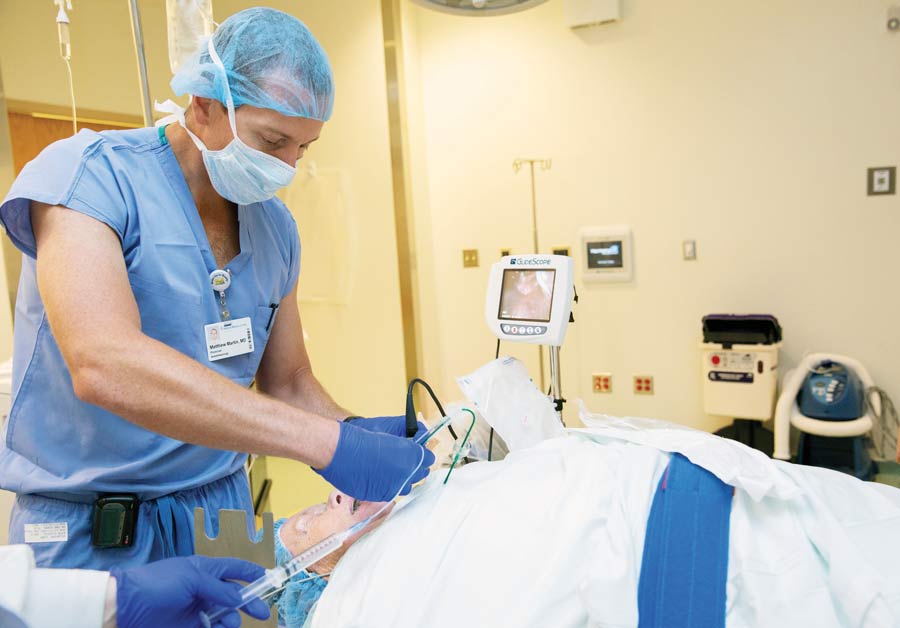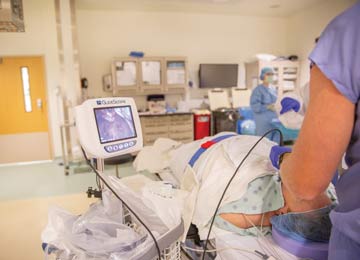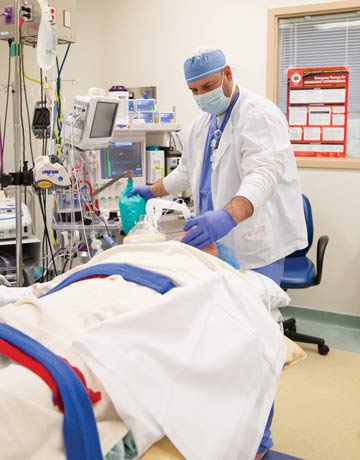When we asked several anesthesiologists to remember back to when they faced challenging intubations, their revelations were honest and insightful. As you read about the cases, consider if your providers have the tools and facility-wide support they need to successfully secure airways in similar scenarios.
- Home
- Article
True-Life Tales of Trying Airways
By: Jared Bilski
Published: 7/23/2019
Anesthesia experts share their most memorable difficult intubations - and what they learned from their experiences.

It was the very last night on call for Carin Hagberg, MD, as chief anesthesiology resident when a Spanish-speaking woman in her late 50s was about to receive general anesthesia for a double mastectomy. Dr. Hagberg didn’t anticipate any issues with the patient’s airway. For good reason. The pre-op exam didn’t reveal obvious issues, and there were no problems noted when the patient was wheeled into the OR. Dr. Hagberg performed a cursory airway exam and proceeded with the induction.

Intubation trouble can sneak up on even the most skilled and diligent anesthesia provider. Luckily, there’s an array of technology and tools at their disposal to aid in difficult airway management.
“The game-changers are the supraglottic airways, including the laryngeal mask airway, and video laryngoscopes,” says Jonathan E. Charnin, MD, an anesthesiologist at the Mayo Clinic in Rochester, Minn.
Video laryngoscopes let providers guide endotracheal tube placement with direct views of the glottis, which isn’t possible with a standard laryngoscope, says Dr. Charnin.
Of course, when assessing any proven technology, you need to make tough choices for your facility. Do your anesthesia providers really need the latest and greatest model? Are all the bells and whistles worth the price or can they get by with more of a bare-bones model? With respect to video laryngoscopes, Dr. Charnin offers some advice.
First and foremost, he says, your providers should feel comfortable with the tool, especially if they’re only using it as a rescue device.
“You want the device to feel like an old friend as opposed to feeling like, I’ve got this new tool that feels fancy, but also a little foreign,” says Dr. Charnin.
Other considerations: ease of use, ergonomics, image quality, portability and screen size. For example, is the viewing screen integrated into the video laryngoscope’s handle or does a fiberoptic cable tether the handle to a separate monitor? Smaller screens integrated into the handle let providers use the device without averting their focus from the patient. “That’s a must-have feature for some anesthesia providers,” says Dr. Charnin.
When Dr. Hagberg performed direct laryngoscopy, she visualized a grade 3 airway and knew she faced a difficult case. She informed the attending physician that there was limited neck movement and that visualization of the glottis was also limited. She attempted to mask ventilate the patient — to no avail. Then, the attending physician tried a direct laryngoscopy and couldn’t see anything. Dr. Hagberg and the attending attempted a 2-person mask ventilation that was unsuccessful.
“Airway trauma resulted and there was now blood in the oropharnyx,” says Dr. Hagberg, who today is the Helen Shaffer Fly Distinguished Professor of Anesthesiology and division head of anesthesiology, critical care and pain medicine at the University of Texas MD Anderson Cancer Center in Houston. “The patient started becoming bradycardic and turning cyanotic. Her stats were dropping. I’ll never forget that sound.”
The situation was becoming dire and the surgeon requested to perform a surgical airway using a scalpel, finger and tube technique. It worked. The patient fully recovered. Dr. Hagberg, however, was forever changed by the experience. She says, “That case is the reason I became involved in difficult airway management and decided to master as many airway skills and techniques as possible.”
2. Expected airway trouble, with an unexpected result

CONSTANT STREAM Instead of providing oxygenation in between airway management attempts, you should be providing oxygenation throughout the entire case.
Even in cases where anesthesiologists anticipate a difficult airway and have a plan in place to react, things can easily go sideways. Such was the case with Leon Chang, MD, associate clinical director and clinical professor in the department of anesthesiology at UC San Diego (Calif.) Health. Dr. Chang was working with a resident to anesthetize a patient with dwarfism, a condition known to cause potentially difficult intubation, so he expected to en-counter some difficulties. When 2 laryngoscopies (one by the resident and one by Dr. Chang himself) proved unsuccessful — as he’d suspected they would — Dr. Chang switched to his plan B.
He proceeded with an intubating laryngeal mask airway (LMA), with the intention of intubating fiberoptically through the LMA and using it as a direct conduit for the endotracheal tube, a technique he had a lot of experience with and one that typically has a very high success rate. Unfortunately, even with the fiberoptic scope being easily passed, the patient’s anatomy made it impossible for Dr. Chang to advance the tube into the trachea.
“With the prior laryngoscopies and minor trauma associated with this unsuccessful fiberoptic attempt, the patient was becoming difficult to ventilate,” says Dr. Chang, who had another trick up his scrub sleeve. “Luckily, we switched to an alternate fiberoptic technique — inserting the fiberoptic scope through an intubating LMA with an Aintree catheter as our conduit — which let us easily place a 7.0 endotracheal tube.
“The case drilled home for me the concept of a ‘perfect tool’ for a perfect situation, and the necessity of being facile with many different intubation techniques,” says Dr. Chang.
3. The difficult airway letter

ON CALL If an anesthesia provider is unable to step away and gather materials from the emergency cart without disrupting the case, any member of the OR team should be prepared to do so.
This memorable case ended with the patient receiving a difficult airway letter that would warn future anesthesia providers about the potential of facing a challenging intubation.
Jonathan E. Charnin, MD, foresaw that the patient’s congenital issues would lead to problems in adulthood that would likely require several surgeries. Establishing the patient’s airway proved challenging, but Dr. Charnin was ready to manage it. “So, after the successful surgery, I sent the patient home with a difficult airway letter,” says Dr. Charnin, an anesthesiologist at the Mayo Clinic in Rochester, Minn.
That letter came in handy for both the patient, who, as expected, wound up having several additional surgeries, and the patient’s anesthesia providers.
“The patient could show up with the difficult airway letter and let future providers know that this was an obstacle that they had to address and manage,” says Dr. Charnin.
Planning for failure
Dr. Hagberg says the mistakes providers commonly make generally fall into 3 categories:
- failure, delay or difficulty in securing the airway;
- aspiration of gastric contents; and
- extubation-related complications.
But it’s human factors that ultimately lead to these mistakes. “It comes down to poor assessment of the airway, poor planning, and a lack of personal and institutional preparedness for managing difficult airways,” says Dr. Hagberg.
Her close call occurred back in 1992 and, as she now notes, “We were not as equipped with intubation aids and devices as we are today. That would’ve been the perfect case for a simple bougie, but they weren’t stocked in the hospital at that time.”
There are some preemptive steps your surgical team should always take to reduce the risk of airways. “Everybody in the OR should know where the difficult airway cart is parked and where specific supplies are located inside it,” says Dr. Charnin. “That way, if anesthesia is unable to step away and gather those materials, anybody in the OR can do it.”
What tools should your anesthesia team have at its disposal for every case, regardless of whether a difficult airway is anticipated? “They must have the appropriate equipment needed to complete each step of the difficult airway algorithm,” says Dr. Chang. “At a minimum, that’s a supraglottic airway such as an LMA, standard laryngoscopy equipment, a fiberoptic scope, a way to establish transtracheal ventilation (jet ventilation) and a video laryngoscope.”
Remember that extubation is just as important as intubation. “In this age of electronic re-cords, team members can turn their backs on the patient at the end of the case,” says Dr. Hag-berg, “but you must remain vigilant at the beginning and end of each and every case.”
Another subtle change that’s being heralded as a critical component of airway management success: oxygenation. “One of the biggest changes we’re seeing today in airway management is the performance of oxygenation throughout the process of securing the airway by apneic oxygenation techniques,” says Dr. Hagberg. “A change that’s already starting to be incorporated into some of the difficult airway guidelines is the use of oxygenation throughout, instead of between, the performance of airway management.”
Perhaps the best strategy for difficult airway management lies in treating every airway as a potentially challenging intubation because, as Dr. Hagberg points out by paraphrasing renowned airway expert Tim Cook, MD, “The biggest mistake practitioners make is the failure to plan for failure.” OSM

Even in cases where anesthesiologists anticipate a difficult airway and have a plan in place to react, things can easily go sideways. Such was the case with Leon Chang, MD, associate clinical director and clinical professor in the department of anesthesiology at UC San Diego (Calif.) Health. Dr. Chang was working with a resident to anesthetize a patient with dwarfism, a condition known to cause potentially difficult intubation, so he expected to en-counter some difficulties. When 2 laryngoscopies (one by the resident and one by Dr. Chang himself) proved unsuccessful — as he’d suspected they would — Dr. Chang switched to his plan B.
He proceeded with an intubating laryngeal mask airway (LMA), with the intention of intubating fiberoptically through the LMA and using it as a direct conduit for the endotracheal tube, a technique he had a lot of experience with and one that typically has a very high success rate. Unfortunately, even with the fiberoptic scope being easily passed, the patient’s anatomy made it impossible for Dr. Chang to advance the tube into the trachea.
“With the prior laryngoscopies and minor trauma associated with this unsuccessful fiberoptic attempt, the patient was becoming difficult to ventilate,” says Dr. Chang, who had another trick up his scrub sleeve. “Luckily, we switched to an alternate fiberoptic technique — inserting the fiberoptic scope through an intubating LMA with an Aintree catheter as our conduit — which let us easily place a 7.0 endotracheal tube.
“The case drilled home for me the concept of a ‘perfect tool’ for a perfect situation, and the necessity of being facile with many different intubation techniques,” says Dr. Chang.

This memorable case ended with the patient receiving a difficult airway letter that would warn future anesthesia providers about the potential of facing a challenging intubation.
Jonathan E. Charnin, MD, foresaw that the patient’s congenital issues would lead to problems in adulthood that would likely require several surgeries. Establishing the patient’s airway proved challenging, but Dr. Charnin was ready to manage it. “So, after the successful surgery, I sent the patient home with a difficult airway letter,” says Dr. Charnin, an anesthesiologist at the Mayo Clinic in Rochester, Minn.
That letter came in handy for both the patient, who, as expected, wound up having several additional surgeries, and the patient’s anesthesia providers.
“The patient could show up with the difficult airway letter and let future providers know that this was an obstacle that they had to address and manage,” says Dr. Charnin.
.svg?sfvrsn=be606e78_3)
.svg?sfvrsn=56b2f850_5)